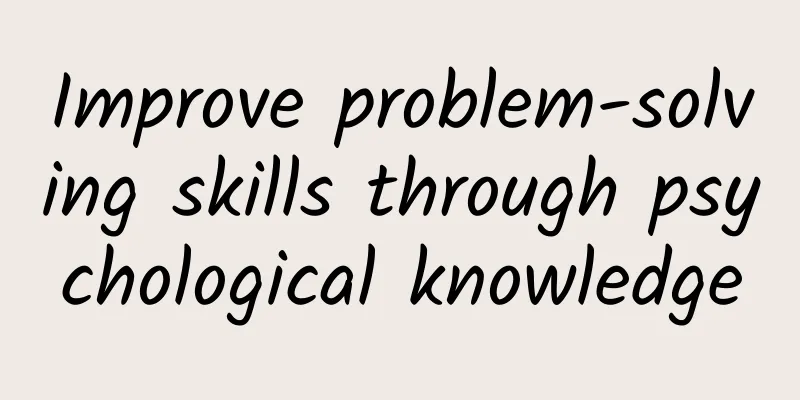Improve problem-solving skills through psychological knowledge

|
Preface Software development work can be seen as a problem-solving process, whether from a macro or micro perspective. From a macro perspective, software development, in simple terms, is to figure out what the customer's needs are, and then solve the problem of how to convert the needs into code through a series of activities such as analysis, design, coding, and testing. From a micro perspective, developers also face a variety of problems in their daily work. For example, the web server used to debug the code suddenly cannot be started, and the developer must solve this problem first, otherwise the work at hand may not be able to proceed. As a developer, instead of complaining about overtime, you should reflect on where your time goes. I believe that most of a developer's time is spent solving various problems. Whether you are a senior developer or a novice, you will encounter various problems in your daily work. The difference is that a senior developer can solve a problem in a few seconds, but a novice may take several hours or even a day or two! It can be seen that improving the problem-solving ability of developers is of great significance both for individuals and for teams. In fact, psychology, as an independent discipline, has its own special research on problem solving. Its research results are worth learning from to improve our own and other team members' problem-solving abilities. This article will introduce readers to the knowledge of psychology on problem solving, and give relevant guidance on improving problem-solving abilities in combination with the characteristics of software development work. Readers without a psychology background do not have to worry about "different fields are like different mountains", as most of the psychology terms involved in this article are easy to understand. Re-examining what a “problem” is To improve problem-solving skills, we must first figure out what the "problem" is, and then we can talk about how to solve the problem more efficiently. Psychology defines a "problem" as "a stimulus situation in which there are certain obstacles between given information and the goal that need to be overcome." In layman's terms, for a given initial state (the so-called "given information") and target state, we don't know how to convert the initial state to the target state (the so-called "obstacle"), and a "problem" arises. For example, the famous Vannota problem, in which the initial state is 64 plates on pole A, and the target state is that all plates are on pole C, and each small plate is above the large plate. The "obstacle" that needs to be overcome is how to move the 64 plates from pole A to pole C. Figure 1. The Tower of Vanoise problem According to the above definition, problem solving is the process of overcoming "obstacles", that is, the process of finding a path from the initial state to the target state. For example, in the Vano Tower problem, we repeatedly use the B pole to finally move all the plates on the A pole to the C pole "intact", which is the process of problem solving. Improving problem-solving skills, then, is about improving our ability to find a path from an initial state to a target state. For the convenience of the following discussion, here we simply divide the "problems" in the field of software development into well-defined problems and ill-defined problems. The former refers to problems where both the initial state and the target state are clear, such as the Vannota problem. The latter refers to problems where the initial state, the target state, or both are very vague. Such problems are often more difficult to solve and require more from the problem solver. Problems related to software operation and maintenance mostly belong to this category. For example, a problem like this: the database system in a production environment automatically restarts, and the cause needs to be found out. The psychological process of problem solving Just as understanding how computers process information helps us use them better, understanding the human problem-solving process helps us solve problems better. Psychologists generally break down the problem-solving process into four steps: problem representation, problem-solving plan design, problem-solving plan execution, and monitoring. Problem representation refers to clarifying the initial state, target state, allowed operations, and restrictions that must be met. In the Vannota problem, the problem solver first represents the problem, that is, to clarify: 64 plates are on pole A, with the small plates on top of the large plates (initial state), the goal is to move these 64 plates to pole C, with each plate on pole C still keeping the small plate on top and the large plate on the bottom (target state), and pole B can be used during the movement, but the small plate is always on top of the large plate during the movement (allowed operations and restrictions that must be met). Designing a solution plan means determining the steps to solve the problem. The Vannota problem solver compares the initial state of the problem with the target state and prepares to recursively move all the plates from pole A to pole C step by step with the help of pole B. This is designing a solution plan. After designing a solution plan, the problem solver will execute the solution plan and constantly check whether the current operation is helpful to solve the problem and whether the related operations meet the constraints of the problem, that is, execution monitoring. For example, when moving the plates of the Vannota problem, the problem solver should pay attention to whether the small plate is on the big plate and whether the result of moving the plates is as expected, so that more and more plates can be placed on the C rod. Next we discuss the psychological factors that influence problem solving. Psychological factors that influence problem solving How to represent the problem The problem representation in the first step of problem solving can be further divided into two small steps: surface understanding and deep understanding of the problem. The surface understanding of a problem is the process of describing the problem in the problem solver's own language, which is the most basic step in solving the problem. The deep understanding of a problem is to further integrate each statement of the problem into a unity of conditions and goals based on the surface understanding of the problem. In this sub-step, it is very important to distinguish between relevant information and irrelevant information in the problem. For irrelevant information, it can be ignored, or it can be understood and expressed in different ways (i.e., representation). In the process of deep understanding of the problem, different ways of representing the problem may have a great impact on the difficulty of solving the problem. This can be reflected in a typical problem - the monk climbing the mountain problem (see the picture above). The intuitive response to the monk climbing the mountain problem is that it seems unlikely that such a point exists, because the monks go up and down the mountain at different speeds. However, when we find that this problem can be seen as such a problem: two monks are at the same time, along the same mountain road, one going down the mountain and the other going up the mountain, the answer is very straightforward: there must be a point on this mountain road, and at a certain moment the two monks will meet. Then, the answer to the original question is also affirmative. The key step in solving this problem is that in the process of deeply understanding the problem, we use a different way to represent the problem from the surface understanding of the problem: in the surface understanding, the problem describes the same monk going up and down the mountain, while in the deep understanding, we find that whether it is a monk going up and down the mountain is "irrelevant" information, and we can understand this information as two monks going up and down the mountain at the same time. Let's take a look at a practical example in software development: we need to verify the legitimacy of the value of a field on a web page that represents a list of article keywords. The verification rule is that the value of the field cannot be empty. If the field value is not empty, multiple keywords are separated by English semicolons. For example: "keyword1; keyword2; keyword3". Obviously, this can be verified using a regular expression. The question then becomes how to write this regular expression. According to the surface understanding of the problem (such as the description of the text above), the format of the field value of the keyword list will be represented as:
Although this representation is straightforward and simple, it is not easy to write the corresponding validation regular expression based on this representation. On the contrary, if the format of the field value is changed to another representation, the corresponding regular expression is much easier to write:
According to the above representation (that is, starting from the second keyword, each keyword needs to be prefixed with ";"), the corresponding regular expression (Javascript language expression) can be obtained as: "^[^;]*(;[^;]+)*$". Therefore, when we are solving problems, especially some difficult ones, if there is no progress and no new ideas, we might as well go back to the origin of the problem, re-characterize the problem, and use a new way to characterize the problem. Perhaps, at this time, it will suddenly become clear. This is like the scene we often see in detective-themed movies and TV shows: the detective spent a lot of manpower and time in the process of investigating the case, but there was no progress. At this time, a good way to break through the difficulties is to start from "zero": go back to the crime scene, look for clues again, and re-think. At this time, the case often becomes clear! Adequacy of problem representation If I had an hour to save the world, I would spend 59 minutes defining the problem and one minute finding solutions––– Albert Einstein. Psychological research shows that experts are much faster than novices in solving routine problems. When solving difficult problems, experts take longer to represent the problem than novices. They spend more time collecting relevant information about the problem, thus representing the problem more fully. There was a case like this. The operation and maintenance personnel reported that the number of processes in a production environment was too many, and asked the R&D personnel for help to locate the problem. The information provided by the other party only said "the number of processes on the host is too many", with an alarm message reported by a monitoring software: "The number of processes on XXX host exceeds 260". The solution to this problem is: first, clarify what the so-called "too many processes" means. Combined with the alarm information of the monitoring software, this question can be answered: the so-called too many processes means that the number of processes started on the host is greater than the number of processes preset by the monitoring software (such as 260). At this point, the problem seems clear: find out which processes are outside of 260 processes, and the problem should be solved. But there is also a problem. Suppose when locating the problem, the number of processes on the host is 265, and each of these processes is the same to us. How can we distinguish these processes into two parts? Further inquiries revealed that the host involved in the problem was one of a cluster environment (with dozens of hosts in total), and it was confirmed that the problem did not occur on other hosts. Then, by comparing the process name list on the host with the process name list of another host in the cluster environment, it can be found which processes are "extra" on the host with the problem. *** found that the problem was caused by the operation and maintenance personnel customizing a scheduled task, and the Shell script called by the scheduled task was repeatedly run (the process corresponding to the previous script run did not end, and the new script run started again), resulting in an increasing number of processes. When the author wrote the above problems as problem location cases and gave them to novices for location location, the novices were confused and didn't know where to start. As shown in the above cases, most of the problems encountered in the software industry are vaguely defined, especially those that occur in production environments. For such problems, experts can use their own analysis and judgment, further collect information related to the problem, gradually transform the problem into a well-defined problem, and then use appropriate problem-solving strategies (such as the above-mentioned comparison method) to solve the problem. Novices are often at a loss. Therefore, the solution to a vaguely defined problem is generally to try to transform it into a well-defined problem by analyzing and judging it and collecting more information about the problem. For novices, observing the problem-solving process of experts and trying to imitate them is also a way to improve their problem-solving ability. Observational skills
In the process of solving problems in the software industry, vision is the main way for the human brain to obtain information. In the process of problem solving, the human brain does not passively accept visual information, but obtains information through conscious and purposeful active observation. In addition, most of the problems encountered in the software development process are vaguely defined problems. Obtaining more information about the problem through observation helps to fully characterize the problem. Therefore, observation ability is very important in the process of problem solving. It is not difficult to find one thing in our daily work: experts can often quickly capture the key information they need from a pile of visual information in the process of problem solving, while novices often turn a blind eye to the information that experts rely on to solve problems! For example, in a Call Stack with dozens of lines of information as shown in Figure 2, an expert can quickly locate the key information in line 35 and conclude that the problem is caused by insufficient disk space, while a novice may not know where to start. Figure 2. Quickly locate key information from error messages The error information presented in log files, software interfaces, etc. is an important source of information for problem location. However, experience tells us that the "80/20 rule" also applies here: most of these error messages are useless or not very useful for problem solving, while the key information that can play a decisive role in problem location and solution is often just a few lines or even one line. Therefore, whether we can quickly find the key information we need from these large amounts of error messages often determines the efficiency of problem solving. To quickly find the key information we need, the problem locator needs to have keen observation skills. To improve observation skills, we first need to realize the importance of observation skills. Secondly, in daily work, we should gradually learn to distinguish the error messages we encounter in the problem locating process, which are critical and which are not very helpful. Thirdly, we should master some basic skills to obtain key information. For example, for database-related error messages, we should be able to focus on the error codes reported by the database system. For Java Call Stack information, focus on the first few lines of the "Caused by" section. The author has helped team members improve their observation skills to a certain extent by guiding them to realize the weakness of their observation skills and the importance of observation skills, and by showing them how to quickly obtain key information through practical problem positioning. summary This article introduces the psychological process of problem solving and some psychological factors that affect problem solving during the problem representation stage. Based on the author's actual experience, this article provides guidance on improving problem location and problem solving capabilities by comparing the differences between experts and novices when solving problems. The next article will introduce other psychological factors that affect problem solving and provide relevant guidance. |
>>: Why is Samsung in such a hurry to compete with Apple, Google, Dell, etc.?
Recommend
Increase the conversion rate of bidding accounts by 20%?
Whether it is a search account or an information ...
The Indian side has determined the location for returning the Chinese soldiers and said it will provide medical services to the Chinese soldiers
The latest report from Indian media said that Ind...
[Aoyama Yuki] Japanese JK uniform youth girl campus portrait photography tutorial
【Aoyama Yuki】Japanese JK Uniform Youth Girl Campu...
Things about APP message push
Part 01 What is push notification? Push notificat...
Uber and Uber are fighting each other in a fierce battle.
Today, UCAR released a series of advertisements o...
Tips for creating a brand from 0 to 1!
If new consumer brands want to complete high-qual...
Android cold start optimization you must master
Preface The incident happened two days before the...
Things you should pay attention to when renting a server hosting provider
1. The "U" of a server is a unit that r...
8 promotion and monetization techniques, which one do you pick?
Today I will share with you the 8 most common mon...
A brief analysis of the key points of Double 11 project operation and promotion!
When it comes to Double 11, I believe everyone is...
AARRR model, analyzing NetEase Wugou Reading!
1. Product Background 1. Product Introduction Net...
Douyin e-commerce from 0 to 1: account creation, traffic, product testing, review...
Once upon a time, there was a group of people mig...
How to create an advertisement that touches people’s hearts? Look here
We all know that marketing is a series of activit...
Tiktok monetization four-day practical course
Course Catalog: Chain fighting technology + matri...
Tik Tok account monetization strategy!
Now that you have fans and traffic, how do you mo...









